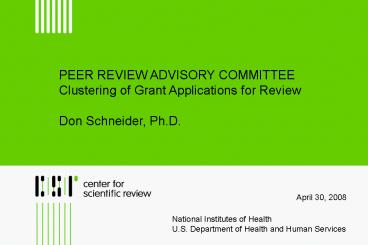Schneider CSR Clustering 05062008 - PowerPoint PPT Presentation
1 / 23
Title:
Schneider CSR Clustering 05062008
Description:
Review by people of the same rank (equals) ... 95% confidence limit, how many data points (applications) are needed, minimally? ... – PowerPoint PPT presentation
Number of Views:197
Avg rating:3.0/5.0
Title: Schneider CSR Clustering 05062008
1
PEER REVIEW ADVISORY COMMITTEE Clustering of
Grant Applications for Review Don Schneider,
Ph.D.
April 30, 2008
National Institutes of HealthU.S. Department of
Health and Human Services
2
Clustering of applications raises questions
- How to express peer review outcomes in consistent
manner - How to compare different review outcomes, with
statistical significance - How to identify orphan applications
- How to promote optimal fairness
3
Peer Review implies clustering
- Review by people of the same rank (equals)
- Broad sense any research scientists who
appreciate/understand the scientific problem - Narrow sense scientists with direct experience
in the area of proposed research - Clustering of very similar applications (bunching
of the same sort together) lends itself to peer
review in the narrow sense
4
PSBR recent trends altered clustering
- Panel on Scientific Boundaries for Review (PSBR)
set a very high bar, 30 clustering (Jan 2000
report) - PSBR de-clustered some communities
- Some areas of science, esp. new areas, bridge
existing study sections, e.g., genetics of human
behavior - Some areas of science are inherently diverse,
e.g., complications of diabetes - Research in some areas of science is diminishing,
e.g., thyroid metabolism - Extreme clustering essentially establishes an
entitlement and is counter to broad study sections
5
PRAC Clustering Working Group
- met 11/30/2007 PRAC 12/3/2007
- Noni Byrnes, CSR
- Patricia Greenwel, CSR
- Ann Hagan, NIGMS
- Leslie Leinwand, PRAC, Colorado
- Don Schneider, CSR
- Ross Shonat, CSR
- Phil Smith, NIDDK
6
PRAC recommended comprehensive study
- Develop statistical tool for assessing
differences in review outcomes - Identify orphan applications just ask staff
can tell you
7
CSR formed Scatter Plot Committee
- Sam Edwards (QVR Searches)
- Brian Hoshaw (Scatter Plots)
- Andrea Kopstein (Planning, Analysis,
Evaluation) - Kristin McNamara (Organizer)
- Chris Sempos (Statistical Tool Odds Ratios)
- Plus Malgorzata Klosek, Tina McIntyre, Marc
Rigas, Don Schneider, Anita Miller Sostek - Methods shared with Chiefs, and established a
team of Statistical Analysis System (SAS) point
persons, one per review division
8
Scatter Plot of select High Low Rep R01s
9
(No Transcript)
10
(No Transcript)
11
Odds Ratio for High Low Rep study sections
12
(No Transcript)
13
Multivariate Logistic Regression example high
vs. low groups
14
Multivariate Logistic Regression Odds Score lt 15
15
Odds Ratio for R01s receiving lt 15 scoreshigh
vs. low
16
Interpret significant differences with caution
- Multiple explanations may account for significant
differences, including degree of clustering and
quality of science do not jump to conclusions - Significant results should be the starting point
for discussion of how to investigate further be
thorough - Nonetheless, the Odds Ratio does provide a very
useful tool of value in assessing scatter plots,
e.g., Skeletal Muscle and Exercise Physiology
(SMEP)
17
Comparing Review Outcomes 2001-03 vs. 2005-07
18
Limitation of Odds Ratio
- QUESTION For odds ratio of 2, with 95
confidence limit, how many data points
(applications) are needed, minimally? - ANSWER About 100
19
R01 Orphan applications across CSR
- Definitions fewer than 5 applications on the
topic per IRG per cycle vs. two or fewer per
study section per cycle - Topic included in guidelines, but expertise
normally not present (broad vs. narrow) - Orphan topics or applications?
20
Asking/Getting answers has complications
- Discussion about what is an orphan application
- Significant fraction of SROs do not respond
another significant fraction report no orphans - Orphans are scattered a basis for comparison
may be arbitrary
21
SUMMARY - Comments from CSR SROs
- Several SROs of regular study sections have no
orphan R01s - Most SROs suggest that two or fewer applications
on a topic per cycle is about right for defining
an orphan - Selected orphan topics are sociocultural factors
affecting bone density, circadian rhythms,
Archaea, sleep disorders, immunology of larynx,
vision driving, blind navigation, transcranial
magnetic stimulation, toxic agents and pregnancy,
toxic agents and heart, massage therapy, host
defense in transplantation, modeling of wound
healing, tobacco toxicology, sepsis, alternative
medicine, pain, monkeys, pure theory such as
modeling of brain oscillations, animal
communications, motion sickness, gastrointestinal
epidemiology, surfactant biophysics, enzyme
nitrosylation, neuro-AIDS and end-organ diseases
like enteritis, AIDS and rare opportunistic
infections, models to test toxicity, prevention
of diabetic foot ulcer, brain vascular
development, Hashimotos thyroiditis, EPR imaging
22
Interim conclusion is that analysis of orphan
applications is challenging
- The Odds Ratio provides a useful statistic for
evaluating significant differences in Scatter
Plots - 95 Confidence in Odds Ratios require about 100
applications/data points - Orphan applications have low numbers, 1-2 per
study section per cycle - To apply statistics to orphan applications, one
must accumulate data over about 50 cycles (gt15
years) or group orphan applications - CSR is in process of identifying orphan
applications (next step poll program staff) and
considering ways to group them
23
Discussion































